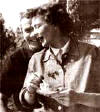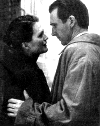
Henry Graham Greene, English novelist, journalist, and playwright, was born on October 2, 1901, in Berkhamsted, Hertfordshire. The fourth of six children, he was an awkward and painfully shy youth. He had no inclination toward sports, and he often cut school so that he could read adventure stories such as those by authors Rider Haggard and R. M. Ballantyne. Such stories influenced him greatly and helped to shape his literary style.
Although many of his works combine elements of the detective story, the spy thriller, and the psychological drama, Greene's weightier novels are mostly stories of the damned. His heroes eventually are forced to face their shortcomings and arrive at salvation only after a long period of suffering and soul-searching agony.
Greene began his life in England, the son of Charles Greene and Marion Raymond Greene, who was a first cousin to author Robert Louis Stevenson. Greene's father, a brilliant intellect, became headmaster at Berkhamsted School. Originally, he had intended to become a barrister, but he discovered that he enjoyed teaching more, although his history lessons were often less lessons than diatribes on why Liberalism had failed society.
Young Greene was educated at Berkhamstead and Balliol College, Oxford. Plagued by debilitating insecurity, he tried running away from home several times. In his teens, he attempted suicide. His parents took him to a therapist who encouraged him to start writing as a means of developing a stronger self-image and a more positive outlook on life. He introduced Greene to several of his literary friends.

Greene quickly learned that he had a natural talent for writing, and during his three years at Balliol, he published more than sixty poems, stories, articles, and reviews, most of which appeared in the student magazine,
Oxford Outlook, as well as in the
Weekly Westminster Gazette. In 1926, he converted to Roman Catholicism, saying afterwards, "I had to find a religion... to measure my evil against." When critics began exhuming the religious undertones in his works, Greene complained that he hated the term being hung on him: "Catholic novelist."
In 1926, Greene moved to London, where he went to work as a reporter for the
Times (1926-30) and for the
Spectator, where he was a film critic and a literary editor until 1940. There, he met Vivien Dayrell-Browning.
She had been a secretary at Blackwell's publishers and wrote to Greene at Oxford, chastising him for his article linking cinema, sex, and religion. The two met for tea and fell in love, although Vivien was slower to yield to Cupid's arrow than was Greene. He began courting her with a letter of apology.
"You carry magic with you always," he wrote her at the beginning of their courtship, "it is in your eyes, & your voice, & your long dark hair, & your whiteness." Vivien, though younger and sexually inexperienced (quite the opposite of Greene), was cooler and more sophisticated when it came to love and kept him at a distance.

The two finally married in 1927. Their relationship spanned two decades, ending with a separation only when a bomb during the Blitz destroyed their lovely and thankfully empty home at 14 Clapham Common, Vivien having already been evacuated with the children. She was terrified at the thought that Greene might have been in the house, but he was secretly living with his paramour, Dorothy Glover, and escaped harm. In an interview, Vivien said later, "Graham's life was saved by his infidelity."
After their relationship ended, he had a string of mistresses, including in the 1950s Swedish actress Anita Björk, whose husband, writer Stig Dagerman, had committed suicide a year earlier. In 1938, Greene began an affair with Dorothy Glover, a theatre costume designer; with whom he would remain close until the late 1940s. She started a career as a book illustrator under the name of Dorothy Craigie, writing children's books of her own, including
Nicky and Nigger and the Pirate (1960).
During World War II, Greene worked "in a silly useless job," as he said afterwards. He was in intelligence for the Foreign Office in London, under Kim Philby, who would later gain notoriety for his defection to the Soviet Union. On one mission to Africa, the writer found little to write home about. "This is not a government house, and there is no larder: there is also a plague of house-flies which come from the African bush lavatories round the house."

Greene returned to England in 1942 and, following the war, traveled the world as a freelance journalist, living for extended periods in Nice on the French Riviera. With his anti-American comments, he gained access to some of the world's major Communist leaders, including Fidel Castro, Ho Chi Minh, Manuel Noriega, and Panamanian dictator Omar Torrijos. But English novelist Evelyn Waugh, who knew Greene better than anyone else, assured in a letter to a friend that the author "is a secret agent on our side and all his buttering up of the Russians is cover.'"

Without bothering to end his affair with Glover, Greene began a simultaneous affair with a stunningly beautiful Catholic convert, Catherine Walston (right), in 1946. Walston was also Greene's goddaughter. Greene met her when, after her conversion to Roman Catholicism, she asked him out of the blue to be her godfather, a ceremony witnessed by Greene's wife, Vivien. He was 42 and internationally celebrated for novels such as
The Power and the Glory. She was 30 and the mother of six children.
Greene met Walston, fell in love, and then sustained a long and passionate affair which was conducted with the full knowledge of all members of both families. Harry Walston himself came to be utterly and helplessly complicit in the relationship. Greene dedicated
The End of the Affair to his paramour. In the book, a writer is having an affair with a neighbor’s wife. He and the neighbor have a strange friendship, as did Greene and Catherine’s husband. When a German bomb hits the building where the lovers are meeting, the woman spontaneously prays to God that she will change her life if only her lover is not dead. Amazingly, he is not. But this sets off a titanic tug-of-war in several characters’ souls about the relative claims of human and divine love.
 The End of the Affair
The End of the Affair was a scandalous success, so much so that some Catholic wags complained that it gave the impression that Christ had said: "If you love me, break my commandments." Greene and Walston were certainly active in doing that. He began rationalizing the affair, going so far as to get confirmation from some priests that it was all right to go to confession again, even knowing that he would immediately return to the illicit liaison. Greene’s earlier sense of the acute tension between earthly and heavenly impulses gradually slid into a more lax form of Catholicism better suited to his own personal lifestyle.
Greene termed his more popular contemporary thrillers--works such as
Orient Express (1932) and
The Ministry of Fear (1943)--mere “entertainments” in an attempt to set them apart from his more serious fiction. His light-hearted romps through populist literature were mostly inspired by his own experiences in the British foreign office in the 1940s and his lifelong ties with SIS.
As both agent and writer, Greene is a crossover between authors such as Christopher Marlowe, Ben Johnson, and Daniel Defoe and more modern day writers such as John Le Carré, John Dickson Carr, Somerset Maugham, and Alec Waugh. The author came by his intrigue with spies and clandestine affairs quite easily. His uncle, Sir William Graham Greene, helped to establish the Naval Intelligence Department, and his oldest brother, Herbert, served as a spy for the Imperial Japanese Navy in the 1930s. Graham's younger sister, Elisabeth, joined MI6 and recruited Graham into the regular ranks of the service.

Greene's most important and enduring works include
Brighton Rock (1938), which was also made into a film (right),
The Power and the Glory (1940),
The Heart of the Matter (1948), and
The End of the Affair (1951), all of which set a tone of high literary, as well as moral, distinction. While Greene may have dabbled from time to time in "entertainments," the majority of his work marks him as a literary novelist of great stature.
He was also a first-rate journalist, something that some critics attribute to his excelling as a novelist. Many of his novels are set in sites of topical journalistic interest: The Quiet American (1955) is the account of early American involvement in Vietnam. Our Man in Havana (1958), set in Cuba, foretells the coming of the Marxist revolution there. A Burnt-Out Case (1961), in the Belgian Congo, takes place just before that nation's struggle for independence. The Comedians (1966), in François Duvalier's Haiti, unfolds before the dictator's overthrow. The Captain and the Enemy (1980), set in Panama, details the rise and fall of the pre-Noriega nation.

In addition to such timely ventures, the author also displays a marked sense of finely honed comedic value in his short-story collection,
May We Borrow Your Husband? (1967), as well as in the novel,
Travels with My Aunt (1969). He also wrote several plays, including
The Living Room (1953) and
The Potting Shed (1957), both thinly disguised religious dramas, as well as
The Complaisant Lover (1959), a witty and intelligent play about marriage and infidelity. He is also noted for his short stories, essays, film critiques, and scripts, including the mystery melodrama,
The Third Man (1950, above).
Not surprisingly, Greene has been the subject of numerous biographies. When professor Norman Sherry started writing his version, Greene gave him a map of the world, marking all of the places he had visited. Sherry decided to go to all of the spots that Greene had marked. He took twenty years to complete the book. Greene limited himself to writing only five hundred words a day and would stop writing even in the middle of a sentence. Nonetheless, he published nearly one hundred books, plays, and scripts in his lifetime.
Graham Greene died in 1991.
AmSAW HOME - AmSAW JOIN - FREE WRITER’S TOOLBAR













